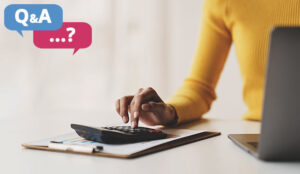Here is a definitive method on how to calculate shrinkage – including the shrinkage formula and a free shrinkage calculator – as endorsed by industry experts, alongside information on how to apply shrinkage to the call centre. Note, this insight can also be applied to how to calculate shrinkage in a BPO.
What is Contact Centre Shrinkage?
Call centre shrinkage is a measure used in planning as a sort of “fudge factor” that allows for the difference between the number of staff that a forecasting system (or Erlang calculator) says is required and the practical considerations of how many employees are available at a particular time.
Shrinkage is any scheduled and/or unscheduled optimization/activities prohibiting employees from performing their duties.
How to Calculate Contact Centre Shrinkage
The Shrinkage Formula for BPO/Contact Centre
To calculate shrinkage for a period you divide the total shrinkage hours (internal shrinkage plus external shrinkage) by the number of hours available, and then multiply this number by 100 to get a percentage.
The ‘shrinkage formula’ (also known as ‘shrinkage calculation’) is as follows:
Shrinkage (%) = (Total Hours of External Shrinkage + Total Hours of Internal Shrinkage ) ÷ Total Hours Available × 100
Note, this is the shrinkage formula that can be used in Excel.

Shrinkage is normally expressed across a complete 12-month period.
What Is Included in the Shrinkage Figure?
There are two main components of shrinkage – external shrinkage and internal shrinkage, as explained below:
1. External Shrinkage (out-of-centre shrinkage)
- Sickness (either run rate or desired level)
- Holiday
- Public holidays
- Paid breaks (if applicable)
- Absenteeism
- Lateness (or tardiness)
2. Internal Shrinkage (in-centre shrinkage)
- Team meetings
- Coaching
- Training
- One-to-ones
- System downtime
- Unplanned facility breaks
- Time spent helping other departments
- Special projects (e.g. time spent fixing broken processes)
Some contact centre planners tend to look at the contact centre shrinkage metric in terms of planned shrinkage and unplanned shrinkage.
For more of the basics on call centre shrinkage, read our article: 2 Minutes on… Shrinkage
Free Download – Call Centre Shrinkage Calculator
Do you want to download a shrinkage calculator to use later?
Get your free download of our Call Centre Shrinkage Calculator now:
How to Calculate a Shrinkage Percentage – With Example
Here is a worked example of the call centre shrinkage calculation based on:
- Working days per year: 260
- Working hours per week: 37.5
| Hours/Week | Days/Year | Shrinkage Days | Percentage | |
|---|---|---|---|---|
| External Shrinkage | ||||
| Annual Leave | 24 | 24 | 9.2% | |
| Public Holidays | 8 | 8 | 3.1% | |
| Sickness | 8 | 8 | 3.1% | |
| Absenteeism/ Lateness | 1 | 1.4 | 0.5% | |
| Internal Shrinkage | ||||
| Training | 5 | 5.0 | 1.9% | |
| Coaching | 5 | 6.9 | 2.7% | |
| Quality Sessions | 2 | 2.8 | 1.1% | |
| Team Meetings | 4 | 5.5 | 2.1% | |
| One to Ones | 1 | 1.4 | 0.5% | |
| Paid Breaks | 5 | 6.9 | 2.7% | |
| Toilet Breaks | 2.5 | 3.5 | 1.3% | |
| System Problems | 1 | 1.4 | 0.5% | |
| Other Activities | 7 | 9.7 | 3.7% | |
| Shrinkage Days | Percentage | |||
| Total | 84.5 | 32.5% | ||
To calculate shrinkage in your contact centre, just like we have in the example above, download our handy Call Centre Shrinkage Calculator in an Excel format.
How to Apply Shrinkage
Shrinkage is the reduction of staff from a theoretical level if a full-time equivalent was able to work all year.
Staff Required = Staff Demand ÷ (100 – Percent Shrinkage ÷ 100) × 100

For example – if an Erlang calculator says that you require 70 agents for a half-hour interval, and you have a shrinkage of 30%, you will probably need to have a staff of 100 agents to cover the demand.
Staff Required = 70 ÷ (100 – 30 ÷ 100) × 100 = 100 Staff

Watch Out for the Shrinkage Trap
Please don’t fall into the trap of adding a percentage shrinkage to the agent requirement, i.e. 70 agents in an interval plus 30% shrinkage (70+30%) = 91.
If you do this, you will be short! The correct calculation is to convert the 30% to 0.3 and calculate 70/(1-0.3) = 100.
Find out how to avoid other WFM traps like this in our article: 7 Deadly Sins of WFM
What Is an Average Shrinkage Figure for the Industry?
Most contact centre professionals seem to agree that shrinkage normally comes out between 30 and 35%.
In their Global Benchmarking Report Dimension Data give an average shrinkage figure of 35%.
Shrinkage vs Utilization
Shrinkage is another way of expressing what used to be called Utilization.
Utilization is simply the number of hours that employees are available to work on their primary task (measured hours), divided by the total paid hours.
So a Shrinkage Figure of 30% equates to a Utilization figure of 70%.
For more information on utilization and the contact centre, read our article: How to Calculate Utilization
Shrinkage + Utilization = 100%
Some companies try to drive up utilization as a way to become more efficient, but that’s bad in the long run, as training is usually the first to go.
To learn why training is important even when understaffed, read our article: 12 Reasons You Shouldn’t Skip Training in a Short-Staffed Call Centre
Shrinkage Does Vary Over Time
Shrinkage does tend to vary across the day and across the year, so you need to measure contact centre shrinkage regularly – don’t use a one-size-fits-all approach.
Across the year, shrinkage tends to be highest across the summer months (particularly over the school summer holidays) and also around Christmas. (This is made worse if the leave/vacation year ends at the end of December.)
Across the day, you may find that shrinkage is highest between 9.00 am and 11.00am and between 14.00 and 15.00, as this is when most team or company meetings tend to be arranged.
How to Control Shrinkage
Our community has also provided some words of warning over the use of call centre shrinkage.
Here is some key advice for controlling shrinkage in any contact centre, BPO or otherwise.
Part-Time Staffing

If you boil it down to just a percentage, you need to be careful to consider the impact of part-time staffing.
For example, an hour one-to-one is a much higher percentage of a person’s day when they only work four hours.
The balance here may be between the flexibility they afford in covering peak hours, or increased ESAT, vs. the impact on costs to run the business.
Contributed by: Robert Tuck
Express Shrinkage in Hours Not a Percent
The value of shrinkage is often commuted as a percentage of staff. However, this is because of how it is applied within capacity plans, and it means little operationally, so it needs to be expressed as hours/mins per day/week/month.
As mentioned, the percentage of overall time is usually calculated per FTE, but the part-time mix does change this value, as does any seasonality for absence.
Contributed by: Keith Stapleton
For more advice like this on improving shrinkage, read our article: Top Tips for Improving Contact Centre Shrinkage
Low Shrinkage May Be a False Economy

The shrinkage KPI, as ever, is less important than the trend and the strategic intent.
For example, very low shrinkage (and therefore high productivity) is a very efficient KPI, but if it comes at the cost of reducing training or coaching, then it is probably a false economy.
Contributed by: Dougie Cameron
Adopt a 2-Stage Process
I have always adopted a simple methodology: include all items that mean people are not available to serve customers.
Doing anything less is simply kidding yourself and will lead to resource shortfalls.
I also adopt a 2-stage calculation process: out-of-centre shrinkage and then in-centre shrinkage, with the latter being calculated on the outcome of the former. This gives a far more accurate number as the in-centre elements can only have an impact if they are actually there.
Contributed by: Gary Saddler
Consider Including Rare Leave Types in Shrinkage Calculations
It may be worth including leave types such as bereavement leave, volunteer leave, and long service leave in your shrinkage calculation.
While these types of leave are less frequently used, factoring them in as a small percentage can help account for their potential impact on agent availability.
However, be cautious—if you recruit additional staff to cover such absences, you could end up double-counting. Assess your team’s historical leave usage and staffing approach to strike the right balance in your calculations.
Contributed by: Fran and Jonty
Know Your Other Staffing Metrics
Don’t make the mistake of thinking that shrinkage and service level are the only metrics that you need when making call centre staffing calculations.
The best possible staffing calculations will also consider occupancy rates and average patience.
Contributed by: Bob
Categorise Shrinkage for Better Control
Consider dividing shrinkage into two categories:
- Productive Shrinkage – Activities that produce outcomes or invest in resources, such as training, 1:1s, coaching, team meetings, and back-office work.
- Unproductive Shrinkage – Internal factors like nonwork AUX codes and unscheduled breaks, as well as external factors like PTO, tardiness, and absenteeism.
This distinction allows for better guidance in addressing controllable vs. uncontrollable shrinkage and helps refine shrinkage control strategies.
Contributed by: Kurstin
Use Only One Method to Apply Shrinkage
In my opinion there are two main ways to apply shrinkage:
- Adding shrinkage to the requirement calculates the total number of staff needed to achieve your operational goals (a “goal-driven” approach).
- Applying shrinkage to scheduled staffing focuses on the net number of available staff after accounting for shrinkage (a “resource-focused” approach).
To avoid confusion, use only one method, as comparing the two can make decision-making more complex. Both methods are valid; the best choice depends on your specific planning needs.
Contributed by: David and Thomas
Click here to use our Call Centre Staffing Erlang Calculator to find out how many staff should be in your call centre at a given time.
Special thanks to the following people who helped to produce the information for this article.
Peter Anderton, Robert Tuck, Phillip Catterall, Richard Powell, Aurelijus Simelevicius, Christel Everaert, Keith Stapleton, Xolani Siphungu, Angela Katimbang, Dougie Cameron, Gary Saddler, Carrie-Anne Dillon, Tracy Macey, Dan Cuthbert, Georgia Poole, Peter Elliot and Matthew Eccles.
Find out how to calculate other important contact centre metrics by reading our articles:
- How to Calculate Contact Centre Service Level
- How to Measure Call Abandon Rate
- How to Calculate Contact Centre Spin
Author: Jonty Pearce
Reviewed by: Hannah Swankie
Published On: 16th Jun 2023 - Last modified: 24th Jan 2025
Read more about - Workforce Planning, Dougie Cameron, Downloads, Editor's Picks, Erlang Calculations, Gary Saddler, How to Calculate, Keith Stapleton, Printable, Robert Tuck, Shrinkage





































